
|
|
Für die deutsche Fassung bitte nach unten scrollen
|
|
|
|
Christmas with Ancient Art
|
A published collection of Roman military diplomas. This newsletter also presents a preview of two important collections, which we recently acquired. The Roman military diplomas originate from the published collection of Peter Weiß, which comprises almost 200 fragments. We will work on them in the next few weeks. The first diploma is presented in this newsletter. We were also able to acquire the last remaining family-owned objects of the now world famous Jovanovic Vinča collection. Around 50 Neolithic figures, vessels and statuettes can now be viewed in our showroom. We are also looking forward to your virtual visit at www.cb-gallery.com. I am convinced you will find a Christmas present that is guarenteed to surprise!
|
|
|
|
Our Highlight of the Month:
|
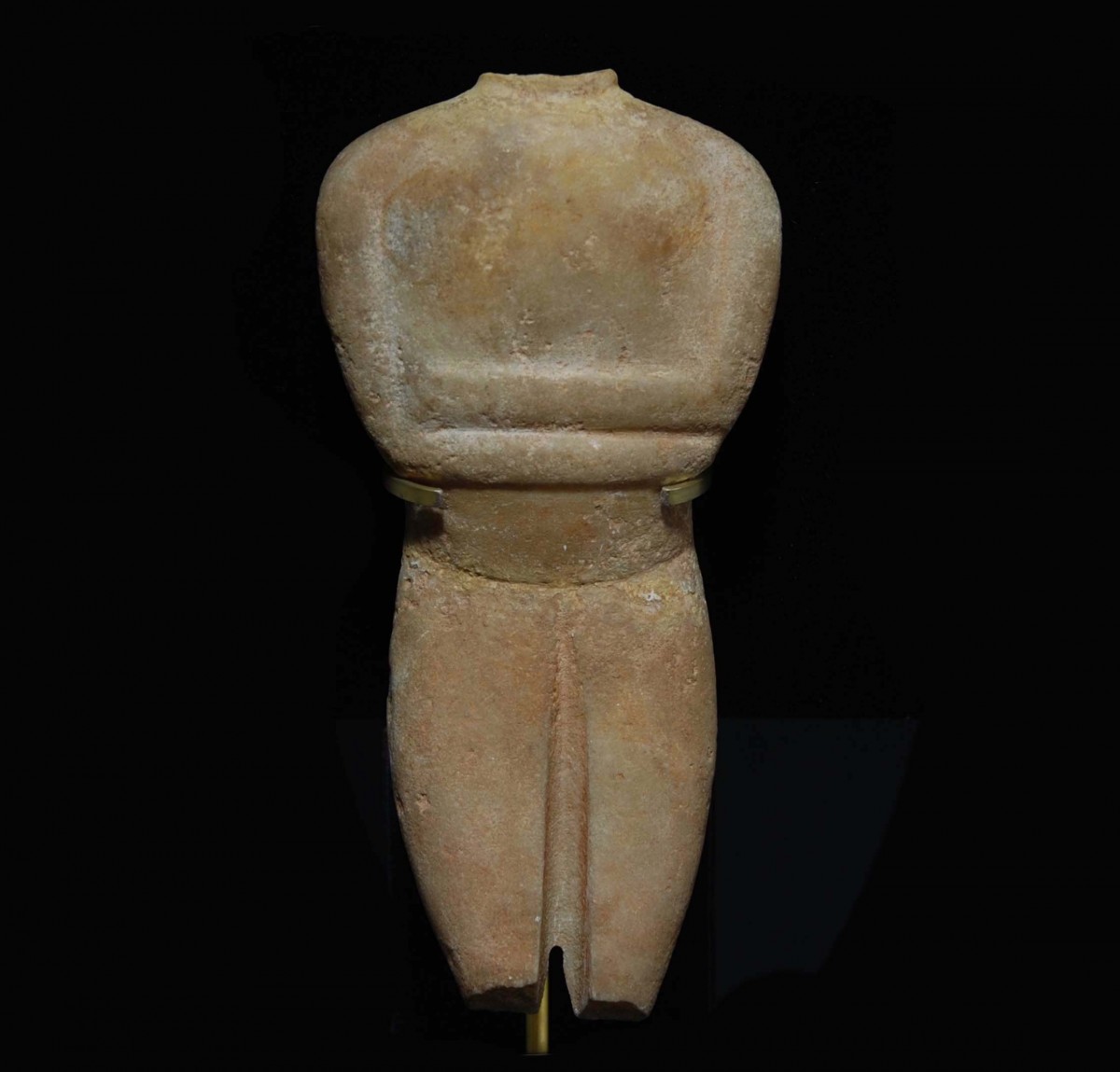
|
|
|
|
|
|
Cycladic Islands – around 2500 B.C.
|
Large, unrestored torso of a Cycladic idol of the Spedos type. The female, highly stylized figure with elongated limbs has rounded shoulders, small, round breasts, and below the breast the arms are folded in parallel on the body. The fingertips of the upper left hand reach to the bend of the right arm. The pelvis is broad and round, the legs are separated by a deeply drawn but not cut through cleft and are slightly curved. Statuettes such as the present one could not stand on their own and were always found lying on the back. The legs are separated from the upper body by a drawn groove This most well-known type of the Cycladic idol was named after an early Cycladic cemetery on the island of Naxos. Mounted.
|
Provenance: From an old Parisian private collection of the 1980s. With a copy of old collection photos. Accompanied by a French antiquities passport.
Dimensions: 15.8 cm high
Price: 38 000 Euro
|
|
|
|
Selected Artworks of the Month:
|
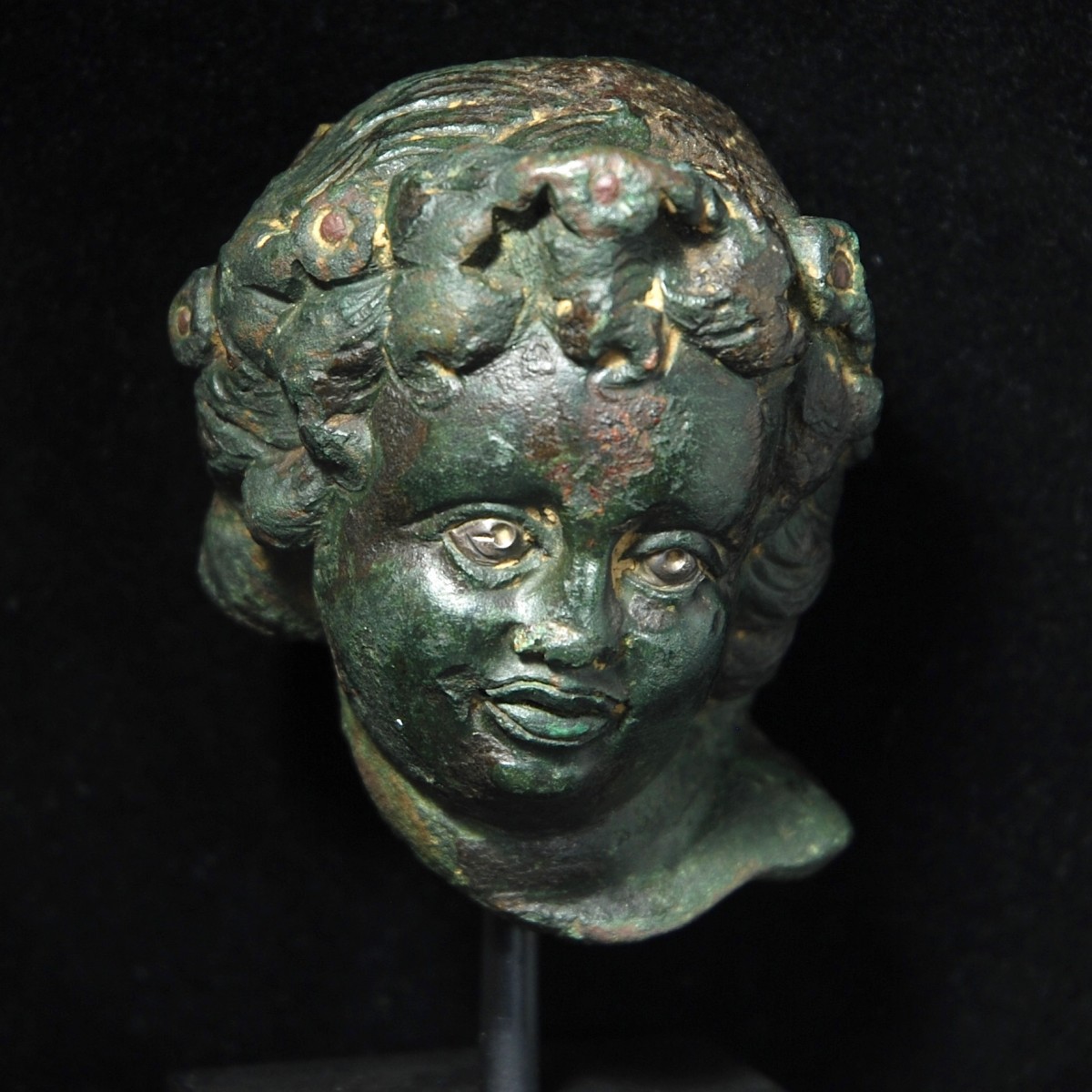
|
|
|
|
|
|
Roman Empire – 2nd century A.D.
|
High-quality bronze head of a childlike Bacchus with wonderful details. The head slightly tilted to the left depicts the young boy with gentle, but vigilant eyes. His gaze seems to be melancholic and dreamy. The inlayed, large silver eyes look out from thick lids. The broad chubby cheeks are slightly stretched upwards and provide the mouth with its broad lips a gentle smile. Next to the nose and on the sides of the mouth, whose lips are possibly covered with copper foils, soft dimples offer a certain liveliness to the face. The hair is thick and elaborately carved. On the sides thick, untamed curls cover the ears. On top of the thick curls of the forehead the young god wears a wreath, the blossoms are inlayed with copper. The upper side of the hair is drawn in thin, disordered strands. A very high-quality head of a Bacchus applique. Mounted.
|
Provenance: Collection Weber, Germany 1980s. Thence in an English private collection.
Dimensions: 7.7 cm high
Price: 12 000 Euro
|
|
|
|
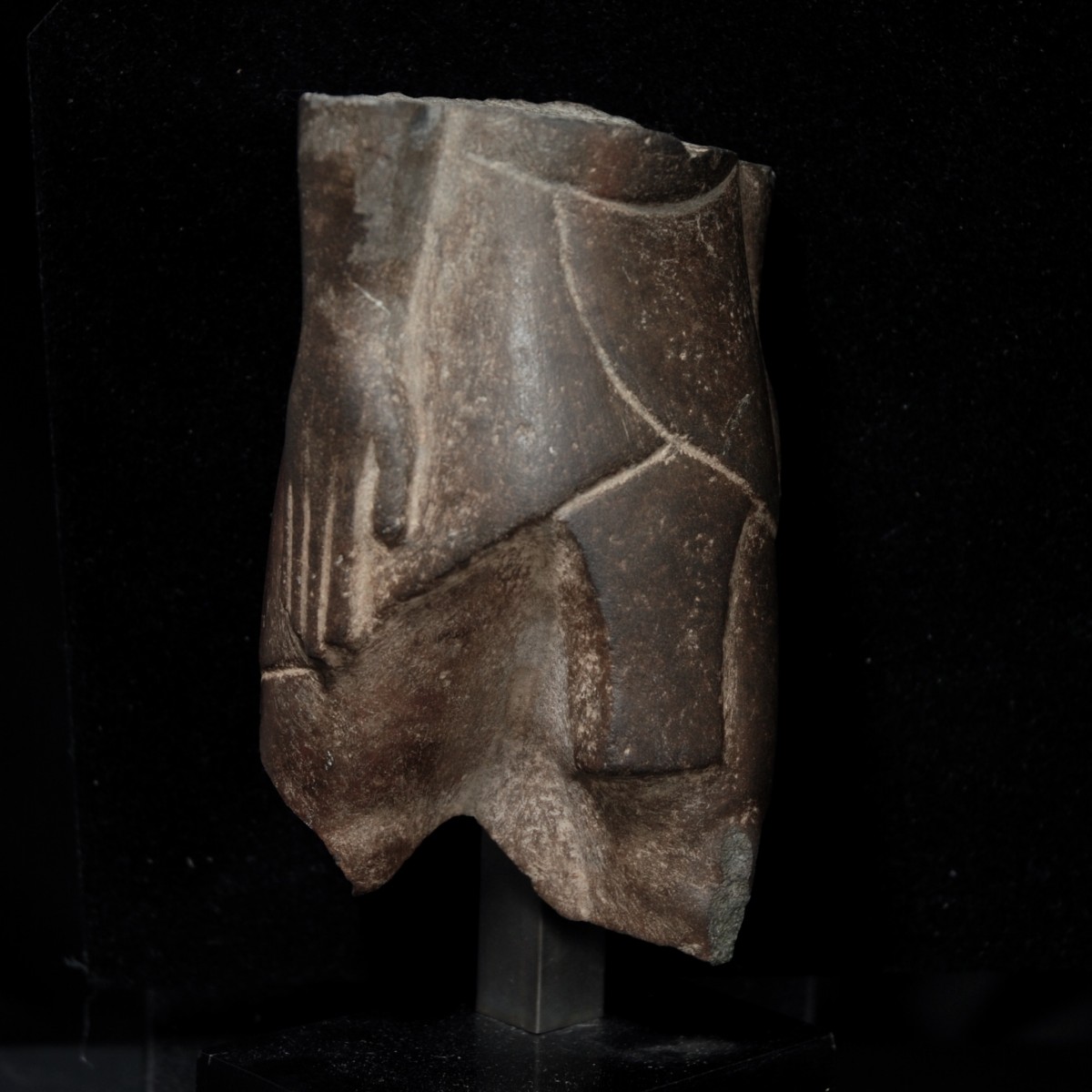
|
|
|
|
|
|
|
|
Egypt – Late period, 664-332 B.C.
|
Very finely worked out basalt torso of a striding man. The arms are placed sideways along the body, the long, thin fingers are stretched out in parallel. The left leg is put forward. The man wears an apron with a central middle sash. A very elegant torso of fine basalt with a beautiful haptic. Mounted.
|
Provenance: Belgian private collection R. W., acquired in the 1960s to the 1970s. Thence in a Parisian gallery. 2017 acquired by the gallery Chenel.
Dimensions: 12.3 cm high
Price: 12 000 Euro
|
|
|
|
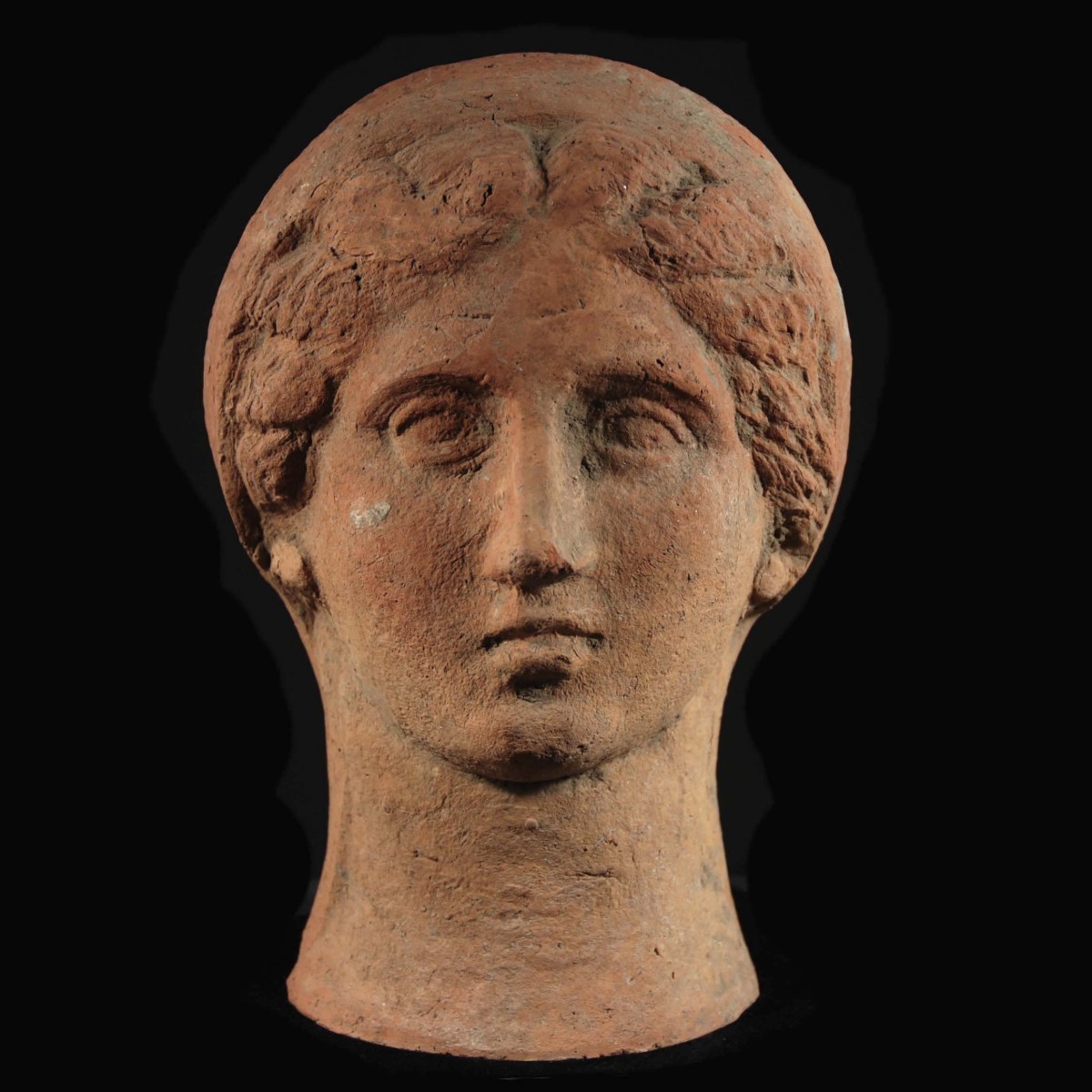
|
|
Etruria – 3rd century B.C.
|
A slightly smaller than life-sized votive head of a woman of reddish clay. The face with gentle features, the eyes look out from thick, slightly pulled down lids. The nose is straight and pointy, the mouth small and slightly open. The woman wears a so-called Melonenfrisur after the Greek fashion. The hair is modelled into ridges going back into a central bun. A veil is pulled over her hair (“capite velato”). At the back a venting hole. With a TL test.
|
Provenance: German private collection R. K., Hessen, acquired prior to 1980. With a TL test of 16 March 2021.
Dimensions: 23.1 cm high
Price: 4 000 Euro
|
|
|
|
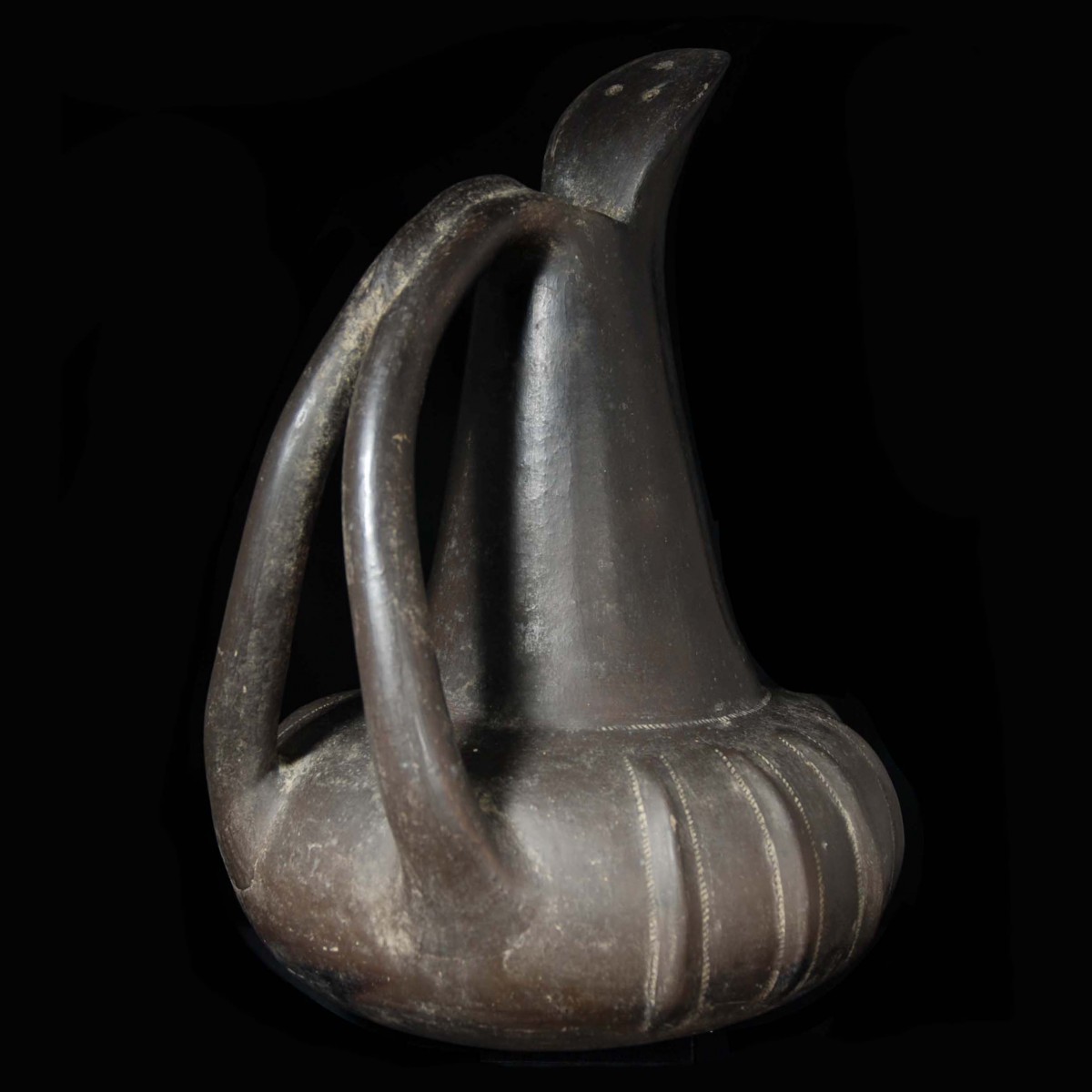
|
|
|
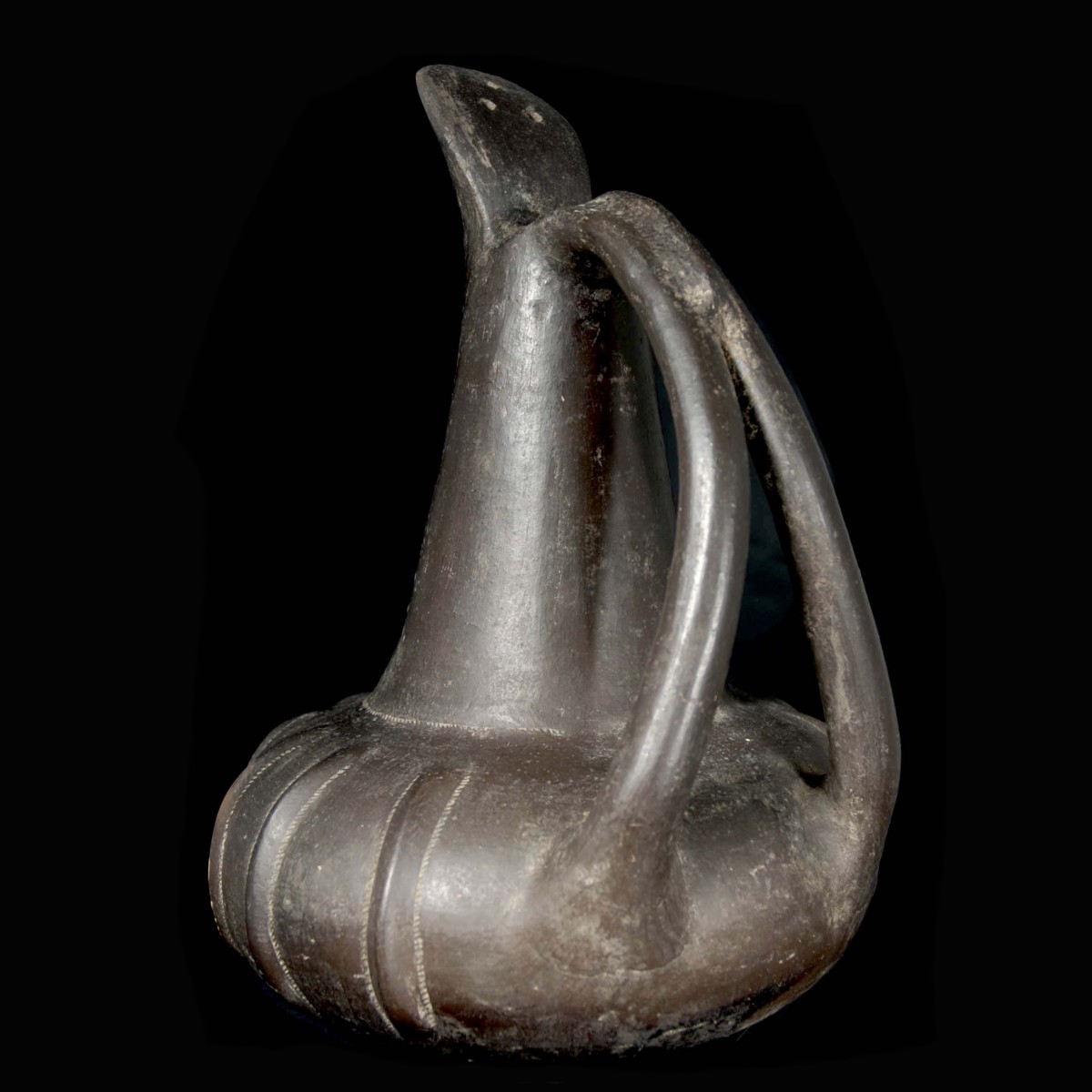
|
|
Etruria – Late 8th to early 7th century B.C.
|
Large beak-spouted jug of the Impasto ware of dark brown clay. The magnificent vessel with a double handle, which starts at the rim and reaches to the widely protruding corpus. The corpus with sculptural ribs flanked by indented line decoration. The spout high towering and with a sieve.
|
Provenance: German private collection R. K., Hessen, acquired prior to 1980.
Dimensions: 29.8 cm high
Price: 6 800 Euro
|
|
|
|
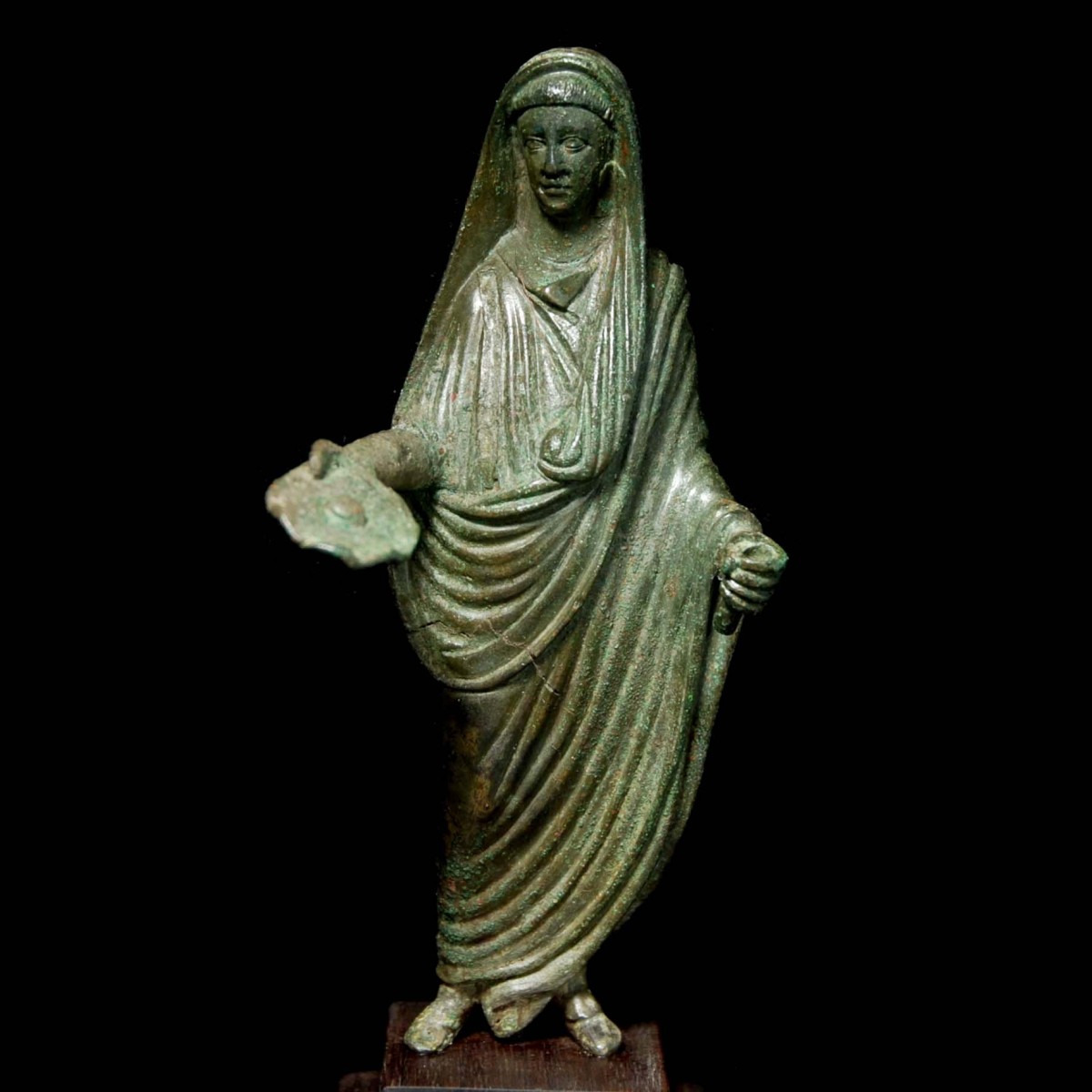
|
|
|
|
|
|
Roman Empire – 1st to early 2nd century A.D.
|
Important bronze statuette of a pontifex maximus filled with lead. The high priest wears a tunic and a long toga (capite velato) of the Imperial period pulled over his head. The toga runs horizontally and is thrown over his belly and over the left shoulder and left arm. Both arms are bent and stretched forward. In the right hand the pontifex holds an offering bowl ("patera"), in his left the handle of another cult object is recognizable. The figure stands with its weight on the left leg, the right one slightly angled backwards. The high priest wears closed boots ("calcei"). The pontifex maximus was the highest ranking in the priest’s college of the pontifices in the Roman Imperium. Since Augustus all Roman emperors held this office until Christianisation. On an old wood base. With an old collection box.
|
Provenance: From an old Japanese private collection, thence Mansour Gallery, London. There in 2013 acquired by an English collector. With an expertise from the University Ferrara of 21 June 2021.
Dimensions: 12.3 cm high
Price: 8 000 Euro
|
|
|
|
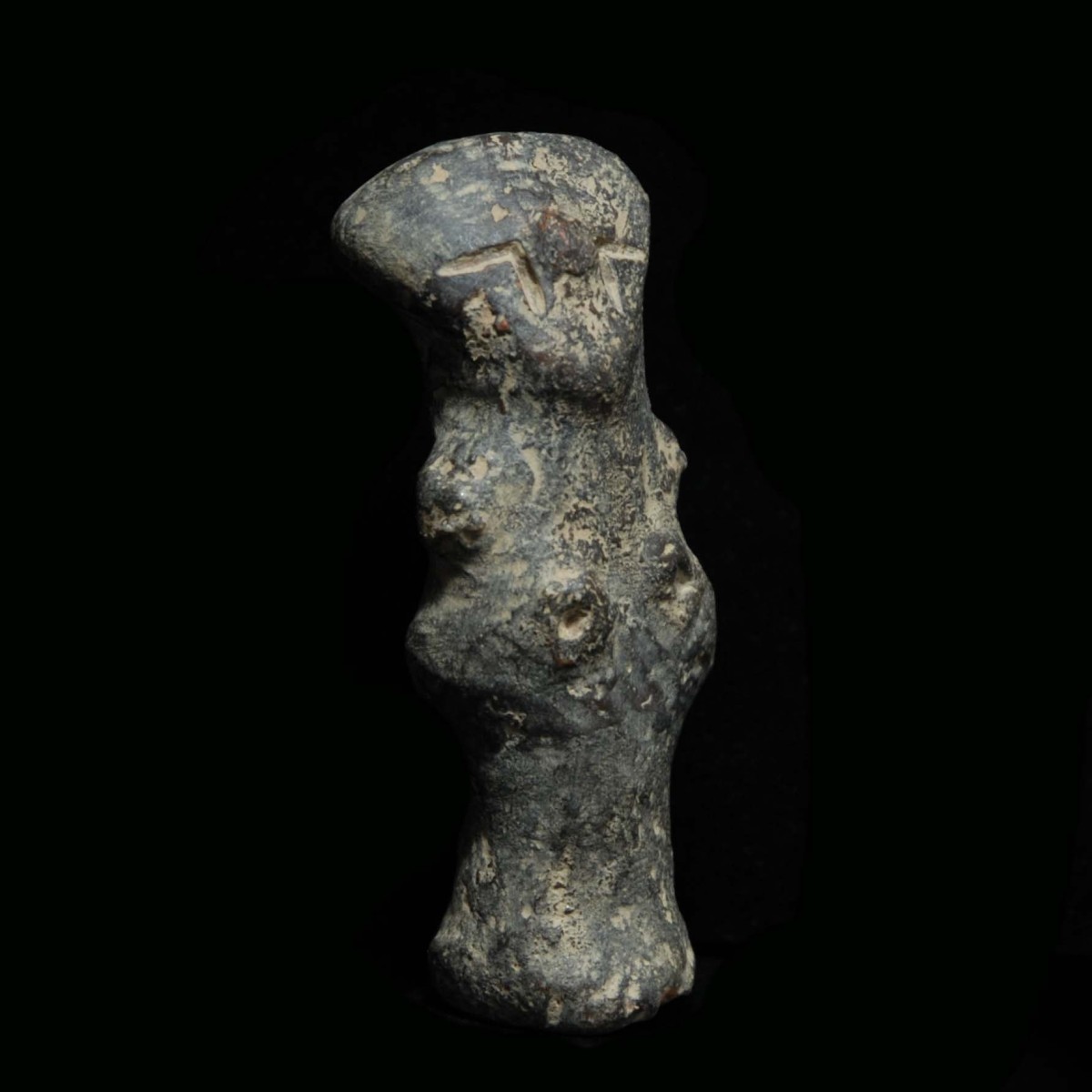
|
|
|
|
|
|
Southeastern Europe – 5500-4500 B.C.
|
Figure of the Vinča culture made of dark clay. The triangular head tilted to the right, with rectangularly incised eyes, as well as a round bulbous nose. The back of the head is far pulled back. The figure has short stump arms, button-like, deep set breasts, a broad hip and a far protruding buttocks. The lower body is compressed, the legs are not accentuated, the figure rather stands on a base with an inwardly pulled stand ring. Vinča figures such as the present one were used for cultic purposes and possibly served as fertility idols. From the region of Supska-Stublina.
|
Provenance: Viennese private collection Dusan Jovanovic (1956-2015), acquired 1970 from Galerie Erwin Richter in Wiener Neustadt, Austria. With a provenance confirmation from Erwin Richter. Since then in a family estate.
Dimensions: 8.2 cm high
Price: 3 600 Euro
|
|
|
|
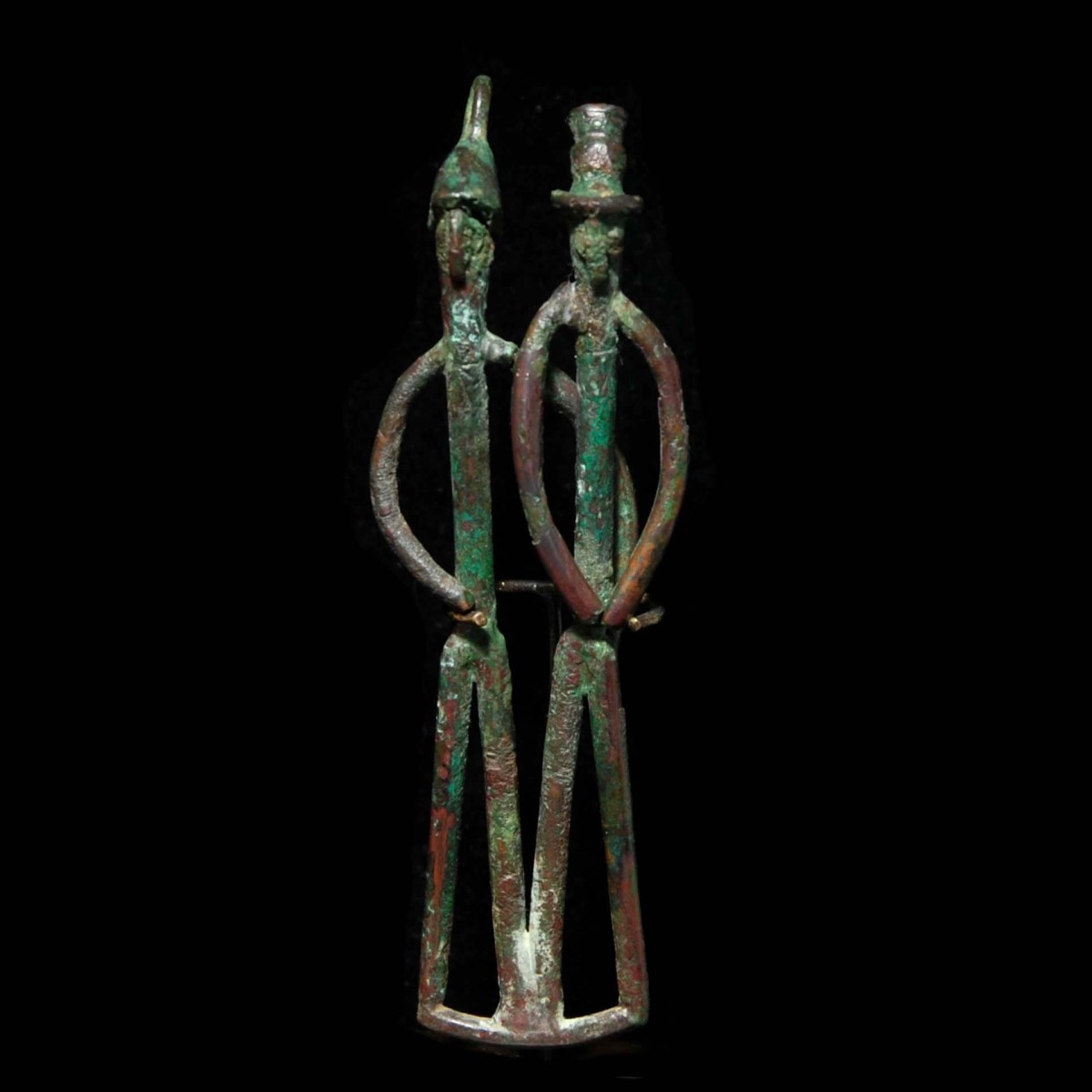
|
|
Amlash – around 1000 B.C.
|
Bronze couple with rod-shaped, elongated bodies and limbs. The couple, which does not show any gender specific characteristics, stands on a joint, slightly downwards rounded plinth. The figures have arms, legs and upper bodies made of round bronze wire. Only the heads and headgear indicate worked out details. The left figure with a long nose and stud eyes wears a high, bell-like headgear with an eyelet. It wraps its left semi-rounded arm around the right figure. The right figure has larger stud eyes and an even more prominent nose, it wears a headgear with a broad brim and a high, layered, cylindrical hat. The right figure has the semi-circular arms placed in front of the body and the hands in front of its private part. Possibly from the southern Caspian region around Amlash. Mounted.
|
Provenance: American private collection, 1980s. On 10 January 2019 auctioned in a US auction house.
Dimensions: 10.2 cm high
Price: 1 600 Euro
|
|
|
|

|
|
|
|
Egypt – Roman period, 1st century A.D.
|
Terracotta statuette of the dwarf-like tutelary Bes as a warrior with a raised sword and shield. The undressed Bes wears a high feather crown. The grotesque face with the tongue sticking out, thick shags, bulging brows, lion-like ears and eyes wide open. Contrary to earlier depictions the features almost human-like are typical for the Hellenistic influence in the Greek-Roman period. Bes had in households and temples always an apotropaic function. He protected against dangerous animals of the desert, such as snakes and scorpions. At the same time, he was worshiped as the god of procreation and birth. He is considered as the protector of pregnant women and newborns. His depictions are therefore often found in women’s rooms and on the heads of beds (especially nuptial beds). The back with a venting hole. See for the depiction in the Museu Nacional de Arqueologia, Lisbon, inventory number E 209, as well as Bonhams auction on 7 July 2016, lot 119. Mounted.
|
Provenance: Private collection Dr. B.C., inventory number 58, acquired from the gallery Carrefour on 21 November 1973. With a copy of the handwritten inventory list of the collection.
Dimensions: 20 cm high
Price: 2 000 Euro
|
|
|
|
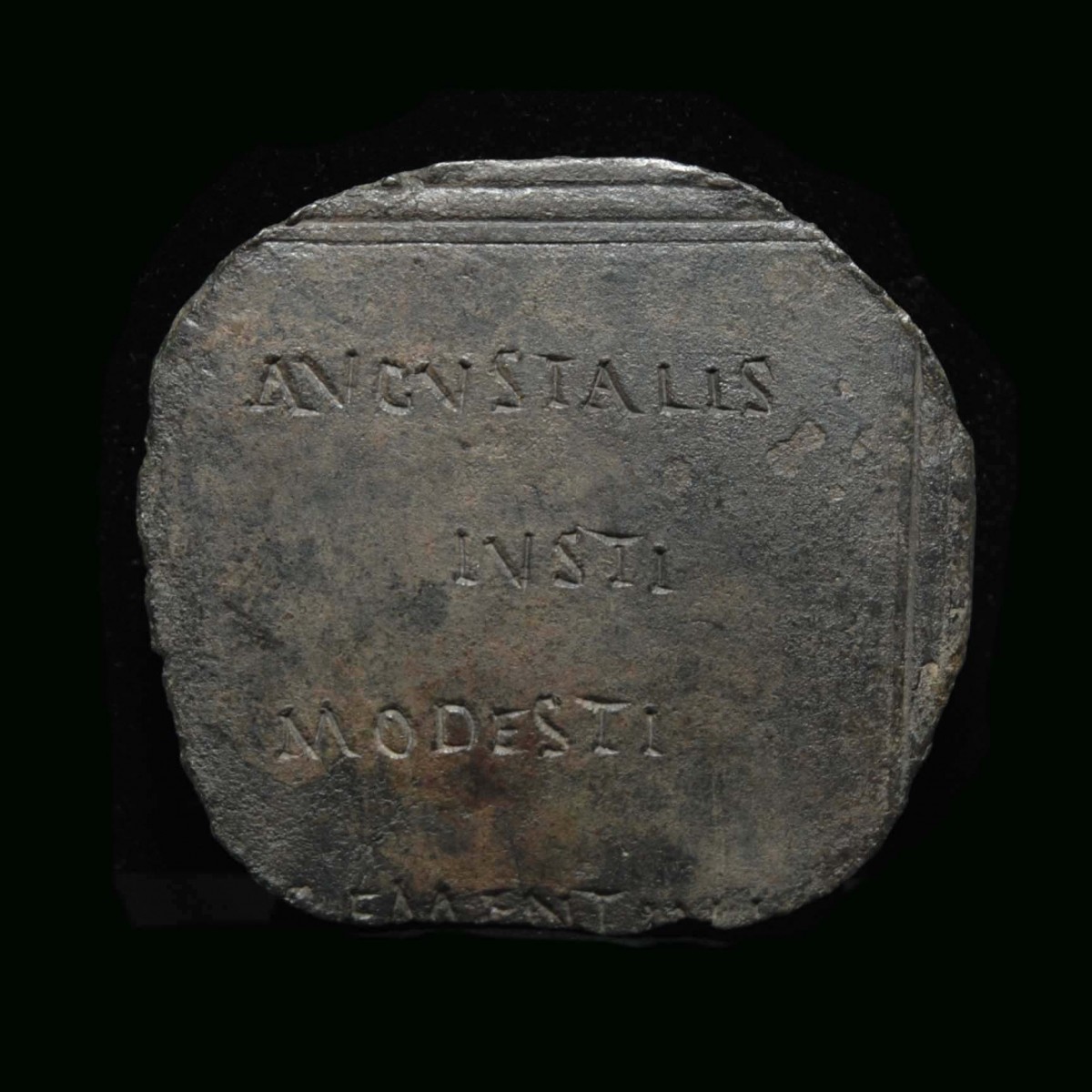
|
|
|
|
|
|
Roman Empire – 7th November 88 A.D.
|
Military diploma of an auxiliary unit from the period of Emperor Domitian under the commander of Aulus Furius Saturninus in the province Syria. The fragment originates from the right upper corner of Tabella II. The fragment was awarded to a member of the cavalry unit ala praetoria singularium. Published in: P. Holder “Roman Military Diplomas V” (2006), p. 723, no. 331. As well as in: Peter Weiß “Zeitschrift für Papyrologie und Epigraphik 117“, 1997, p. 232-233.
|
Provenance: From the German collection Peter Weiß, acquired between 1967 and 2015.
Dimensions: 7.2 cm x 8.3 cm
Price: 1 600 Euro
|
|
|
|
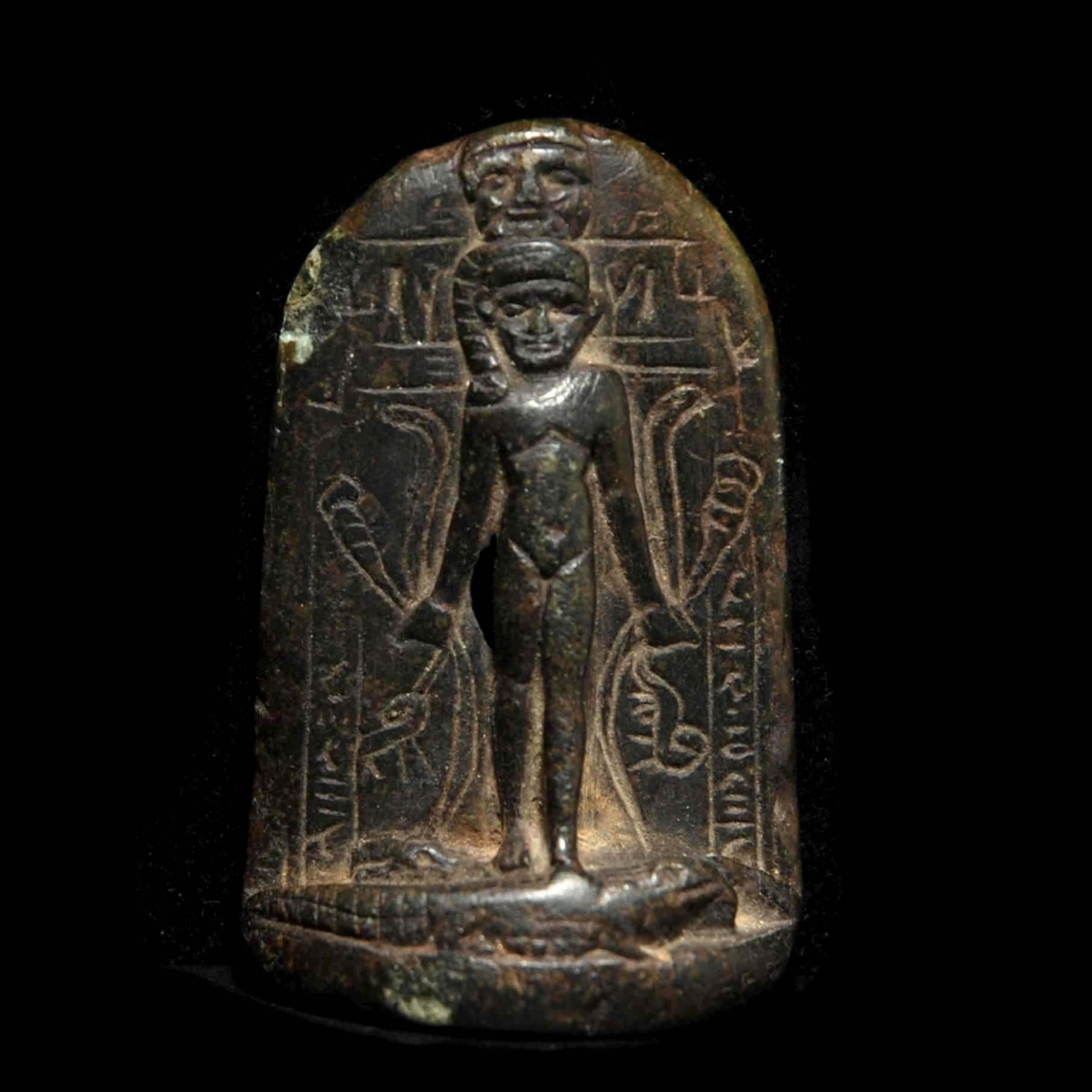
|
|
Egypt – Ptolemaic period, 32-30 B.C.
|
Horus stele of black steatite. The top part of the stone is rounded with a stage-like, protruding base on which the undressed Horus child (Harpocrates) stands. He has the lock of youth cascading on the side. His hands hold scorpions and snakes. Horus stands with the left leg put forward on two crocodiles, representing the restrained power of Set (the evil, the patricide). As a crown Horus wears the face of Bes, the protector of youth and against evil animals. Inscriptions next to the head and along the figure call on Isis, who should stand by her son’s side. In addition, the text reads magic formula protecting against snake bites, scorpion venom and other wild animals. Small magic steles such as the present one were used in private households. They were placed in water hoping that it will be charged with positive energy. If one was bitten by a snake or stung by a scorpion this “healing water” was given hoping for recovery. Mounted.
|
Provenance: German private collection M. B. acquired prior to 1970.
Dimensions: 6.3 cm high
Price: 3 600 Euro
|
|
|
|
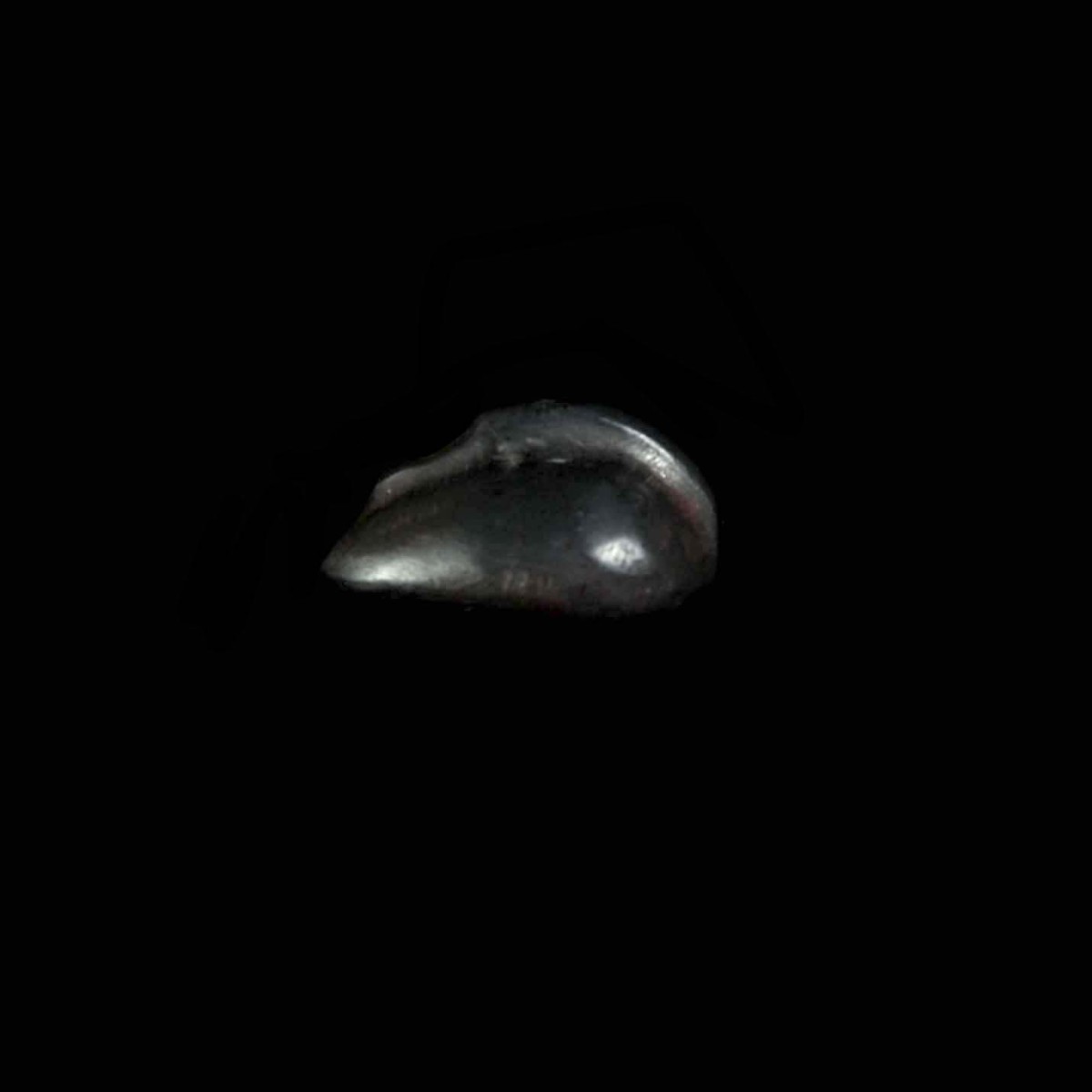
|
|
Mesopotamia – Mid 2nd millennium B.C.
|
Almost metallically appearing weight of dark grey hematite in form of a crouching duck, putting its head over its shoulder to the back. The neck is long and slender, the beak with a raised ridge. The tail feathers are accentuated by a gentle widening. The base of the small sculpture is flat. The so-called “sleeping duck” is a common weight form in the Near East. The earliest examples originate from the Sumerian excavation sites of the 3rd millennium B.C.
|
Provenance: English private collection, 1980s. Thence 2016 with Rupert Wace Ancient Art in London.
Dimensions: 2.1 cm long
Price: 800 Euro
|
|
|
|
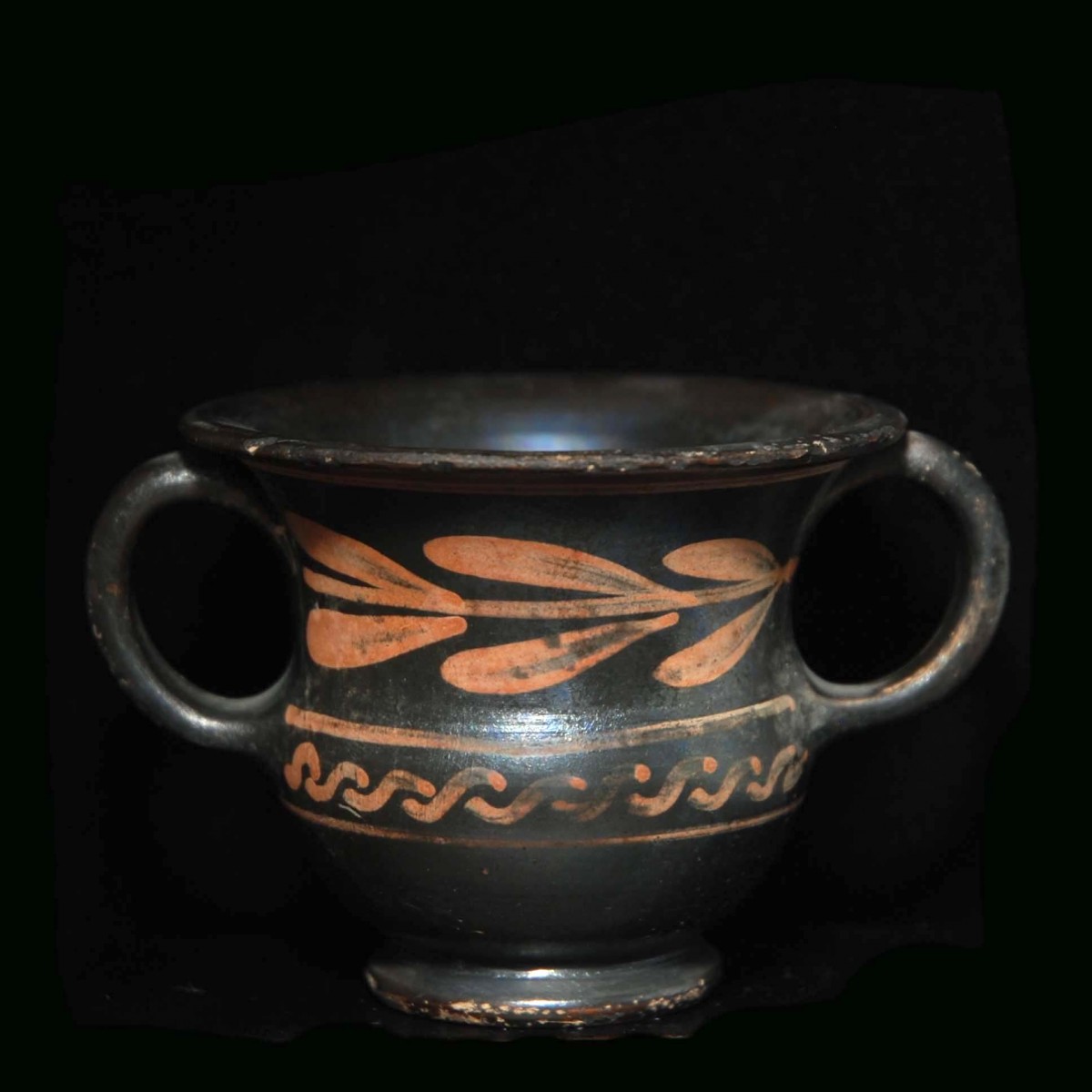
|
|
|
|
Greece/Apulia – 4th century B.C.
|
Small jug of the so-called Xenon Group who mostly applied ornamental decoration with red slip on the black-glazed pottery. The small kantharos with vertical handles, a set off ring foot and protruding rim. The paint depicts encircling laurel leaves and a hair band with dots below.
|
Provenance: Private collection Karl Zieger (1939-2021), Lower Austria. Acquired on 19 June 1997 from Dorotheum Vienna. With an original certificate.
Dimensions: 5.6 cm high
Price: 800 Euro
|
|
|
|

|
|
|
|
|
|
Greece/Apulia – 4th century B.C.
|
Black-glazed bowl on a profiled ring foot (kylix) with horizontally protruding, raised handles which rise above the rim of the bowl. The kylix is painted in white, red, yellow and black inside. On the rim inside an encircling garland of leaves. In the tondo a running stag to the right surrounded by a white circle with black lines and red border.
|
Provenance: Private collection Karl Zieger (1939-2021), Lower Austria. Acquired in the late 1990s from the Galerie Socowi in Vienna. With an original expertise.
Dimensions: 7 cm high; 23 cm in diameter
Price: 600 Euro
|
|
|
|
|
|
Weihnachten mit antiker Kunst
|
|
|
|
|
Unser Highlight des Monats:
|
|
Kykladen – um 2500 v. Chr.
|
Großer, unrestaurieter Torso eines Kykladen-Idols des Typs Spedos. Die weibliche, stark stilisierte Figur mit überlangen Gliedmaßen hat abgerundete Schultern, kleine, runde Brüste und unter den Brüsten parallel an den Körper angelegte Arme. Die Fingerspitzen der oberen linken Hand reichen dabei bis zur Beuge des rechten Arms. Das Becken ist breit und rund, die Beine sind durch einen tief gezogenen, aber nicht durchbrochenen Spalt getrennt und leicht abgewinkelt. Statuetten wie diese konnten nicht von selbst stehen und wurden stets am Rücken liegend aufgefunden. Die Beine sind vom Oberkörper durch eine gezogene Rille getrennt. Dieser bekannteste Typ der Kykladen-Idole wurde nach einem frühkykladischen Friedhof auf der Insel Naxos benannt. Gesockelt.
|
Provenienz: Aus alter Pariser Privatsammlung 1980er Jahre. Mit Kopien alter Sammlungsfotos. Mit französischem Antikenpass.
Höhe: 15,8 cm
Price: 38.000 Euro
|
|
|
|
Ausgewählte Kunstwerke des Monats:
|
|
Römisches Reich – 2. Jahrhundert n. Chr.
|
Hochwertig gearbeiteter Bronzekopf des kindlichen Bacchus mit wunderbaren Details. Der leicht nach links geneigte Kopf zeigt den Knaben mit sanften, aber wachen Augen. Sein Blick scheint melancholisch und verträumt. Die eingelegten, großen Silberaugen blicken aus dicken Lidern hervor. Die breiten Pausbacken sind leicht nach oben gezogen und verleihen dem Mund mit seinen üppigen Lippen ein sanftes Lächeln. Neben der Nase und seitlich des Mundes, dessen Lippen wohl mit Kupferfolien belegt sind, geben sanfte Grübchen dem Gesicht eine besondere Lebendigkeit. Das Haar ist dicht und aufwändig gestaltet. Seitlich bedecken dicke, ungezähmte Locken die Ohren. Über den dichten Stirnlocken trägt der junge Gott einen Blütenkranz, die Blüten sind dabei in Kupfer eingelegt. Auf der Oberseite ist das Haar in dünnen, ungeordneten Strähnen gezeichnet. Ein besonders hochwertiger Kopf einer Bacchus-Applike. Gesockelt.
|
Provenienz: Sammlung Weber, Deutschland 1980er Jahre. Danach in einer englischen Privatsammlung.
Höhe: 7,7 cm
Preis: 12.000 Euro
|
|
|
|
|
Ägypten – Spätzeit, 664-332 v. Chr.
|
Sehr fein gearbeiteter Basalt-Torso eines schreitenden Mannes. Die Arme sind seitlich an den Körper angelegt, die langen, dünnen Finger parallel ausgestreckt. Das linke Bein ist vorangestellt. Der Mann trägt einen Schurz mit zentraler Mittelschärpe. Ein sehr eleganter Torso aus feinem Basalt mit wunderbarer Haptik. Gesockelt.
|
Provenienz: Belgische Privatsammlung R. W., erworben in den 1960er bis 1970er Jahren. Danach in einer Pariser Galerie. 2017 erworben von der Galerie Chenel.
Höhe: 12,3 cm
Preis: 12.00 Euro
|
|
|
|
|
Etrurien – 3. Jahrhundert v. Chr.
|
Leicht unterlebensgroßer Votivkopf einer Frau aus rötlichem Ton. Das Gesicht mit sanften Zügen, die Augen blicken unter dicken, leicht nach unten gezogenen Lidern hervor. Die Nase ist gerade und spitz, der Mund klein und leicht geöffnet. Die Frau trägt eine sogenannte Melonenfrisur nach griechischer Mode. Dabei ist ihr Haar in verschiedene geflochtene Segmente unterteilt und nach hinten geführt. Über das Haar hat sie einen Schleier gezogen („Capite Velato“). Hinten Brennloch. Mit TL-Test.
|
Provenienz: Deutsche Privatsammlung R. K., Hessen, erworben vor 1980. Mit TL-Test vom 16. März 2021.
Höhe: 23,1 cm
Preis: 4.000 Euro
|
|
|
|
|
Etrurien – Ende 8. bis Anfang 7. Jahrhundert v. Chr.
|
Große Schnabelkanne der Impasto-Ware aus dunkelbraunem Ton. Das prachtvolle Gefäß mit Doppelhenkel, der am Rand ansetzt und bis zum breit ausladenden Korpus reicht. Der Korpus mit plastischen Rippen, die von eingedrücktem Schnurdekor flankiert werden. Der Ausguss hoch aufragend und mit Siebfunktion.
|
Provenienz: Deutsche Privatsammlung R. K., Hessen, erworben vor 1980.
Höhe: 29,8 cm
Preis: 6.800 Euro
|
|
|
|
|
Römisches Reich – 1. bis Anfang 2. Jahrhundert n. Chr.
|
Bedeutende mit Blei gefüllte Bronze-Statuette eines Pontifex Maximus. Der Hohepriester trägt eine Tunika und eine lange über das Haupt gezogene Toga (capite velato) der Kaiserzeit. Die Toga verläuft horizontal über den Bauch und ist über die linke Schulter und den linken Arm geschlagen. Beide Arme sind abgewinkelt und nach vorne gestreckt. In der rechten Hand hält der Pontifex eine Opferschale („Patera“), in der linken ist noch der Henkel eines weiteren Kultobjekts erkennbar. Die Figur steht mit dem Gewicht auf dem linken Bein, das rechte ist leicht nach hinten abgewinkelt. An den Füßen trägt der Hohepriester geschlossene Stiefel („Calcei“). Der Pontifex Maximus war der ranghöchste im Priesterkollegium der Pontifices im Römischen Reich. Seit Augustus hatten alle römischen Kaiser bis zur Christianisierung dieses Amt inne. Auf altem Holzsockel. Mit alter Sammlungsbox.
|
Provenienz: Aus alter japanischer Privatsammlung, danach Mansour Gallery, London. Dort 2013 erworben von einem englischen Sammler. Mit Expertise der Universität Ferrara vom 21. Juni 2021.
Höhe: 12,3 cm
Preis: 8.000 Euro
|
|
|
|
|
Südosteuropa – 5500-4500 v. Chr.
|
Figur der Vinča-Kultur aus dunkelm Ton. Der leicht nach rechts gewandte, dreieckige Kopf mit rechtwinkelig eingeritzten Augen sowie runder Knollnase. Der Hinterkopf weit nach hinten gezogen. Die Figur hat kurze Stummelarme, knopfartige, tiefsitzende Brüste, eine breite Hüfte und ein nachhinten weit ausladendes Gesäß. Der Unterkörper ist gestaucht, die Beine sind nicht akzentuiert, die Figur steht vielmehr auf einem unten nach innen gezogenen Standring. Vinča-Figuren wie diese wurden für kultische Zwecke eingesetzt und dienten wohl als Fruchtbarkeitsidole. Aus der Gegend von Supska-Stublina.
|
Provenienz: Wiener Privatsammlung Dusan Jovanovic (1956-2015), erworben 1970 in der Galerie Erwin Richter in Wiener Neustadt. Mit Provenienzbestätigung von Erwin Richter. Seitdem in Familienbesitz.
Höhe: 8,2 cm
Preis: 3.600 Euro
|
|
|
|
Bronze-Pärchen mit stabförmigen, überlangen Körpern und Gliedmaßen. Das Paar, das keine geschlechtsspezifischen Merkmale aufweist, steht auf einer gemeinsamen, leicht nach unten abgerundeten Plinthe. Die Figuren haben Arme, Beine und Oberkörper aus rundem Bronzedraht. Nur die Köpfe und Kopfbedeckungen weisen ausgearbeitete Details aus. Die linke Figur mit langer Nase und Knopfaugen trägt eine hohe, glockenartige Kopfbedeckung, auf der eine Öse aufsitzt. Sie legt ihren linken halbrunden Arm um die rechte Figur. Die rechte Figur hat größere Knopfaugen und eine noch ausgeprägtere Nase, sie trägt eine Kopfbedeckung mit breiter Krempe und hohem, abgestuftem, zylinderförmigem Aufsatz. Die rechte Figur hat die halbrunden Arme vor den Körper und die Hände vor das Geschlecht gelegt. Wohl aus der südkaspischen Region um Amlash. Gesockelt.
|
Provenienz: Amerikanische Privatsammlung, 1980er Jahre. Am 10. Jänner 2019 in einem amerikanischen Auktionshaus versteigert.
Höhe: 10,2 cm
Preis: 1.600 Euro
|
|
|
|
|
Ägypten – Römische Zeit, 1. Jahrhundert n. Chr.
|
Terrakotta-Statuette des zwergenhaften Schutzgottes Bes als Krieger mit erhobenem Schwert und Schild. Der unbekleidete Bes trägt eine hohe gefiederte Krone. Das fratzenartige Gesicht mit herausgestreckter Zunge, dicken Bartzotteln, wulstigen Brauen, löwenähnlichen Ohren und weit offenen Augen. Die im Gegensatz zu früheren Darstellungen schon menschlich wirkenden Gesichtszüge sind typisch für den hellenistischen Einfluss in griechisch-römischer Zeit. Bes hatte im Haushalt und Tempel stets apotropäische Funktion. Er schützte vor den gefährlichen Tieren der Wüste wie Schlangen und Skorpionen. Gleichzeitig wurde er als Gott der Zeugung und der Geburt verehrt. Er gilt als Beschützer der Schwangeren und Neugeborenen. Seine Abbildungen sind deshalb häufig in Frauengemächern und an den Kopfenden von Betten (insbesondere Hochzeitsbetten) zu finden. Die Rückseite mit Brennloch. Vergleiche zur Darstellung Museu Nacional de Arqueologia, Lisbon, Inventarnummer E 209 sowie Bonhams Auktion vom 7. Juli 2016, Los 119. Gesockelt.
|
Provenienz: Privatsammlung Dr. B. C., Inventarnummer 58, erworben in der Galerie Carrefour am 21. November 1973. Mit Kopie aus dem handschriftlichen Inventarverzeichnis der Sammlung.
Höhe: 20 cm
Price: 2.000 Euro
|
|
|
|
|
Römisches Reich – 7. November 88 n. Chr.
|
Militärdiplom einer Auxiliareinheit aus der Zeit des Kaisers Domitian unter der Kommandantur des Aulus Furius Saturninus in der Provinz Syria. Das Fragment stammt aus der rechten oberen Ecke der Tabella II. Verliehen wurde das Fragment an einen Angehörigen der Reitereinheit Ala praetoria singularium. Publiziert in: P. Holder „Roman Military Diplomas V" (2006), S. 723, Nr. 331. Sowie in: Peter Weiß „Zeitschrift für Papyrologie und Epigraphik 117“, 1997, S. 232-233.
|
Provenienz: Aus der deutschen Sammlung Peter Weiß, erworben zwischen 1967 und 2015.
Dimensionen: 7,2 cm x 8,3 cm
Preis: 1.600 Euro
|
|
|
|
|
Ägypten – Ptolemäische Zeit, 32-30 v. Chr.
|
Horus-Stele aus schwarzem Steatit. Der oben abgerundete Stein mit unten bühnenartig hervorstehender Basis, auf der das unbekleidete Horuskind (Harpokrates) steht. Er trägt die Locke der Jugend, die seitlich herabhängt. In seinen Händen hält er Skorpione und Schlangen. Horus steht mit dem linken Bein nach vorne auf zwei Krokodilen, die für die gebändigte Kraft des Seth (des Bösen, des Vatermörders) stehen. Als Krone trägt Horus das Gesicht des Bes, des Beschützers der Jugend und vor bösen Tieren. Inschriften neben dem Kopf und seitlich der Figur rufen Isis an, die ihrem Sohn zur Seite stehen soll. Darüber hinaus handelt es sich um Zaubertexte, die vor Schlangenbissen, dem Gift des Skorpions und anderen wilden Tieren schützen. Kleine magische Stelen wie diese wurden im privaten Bereich eingesetzt. Sie wurden in Wasser getaucht, in der Hoffnung, das Wasser würde sich mit positiver Energie aufladen. Wurde jemand von einer Schlange gebissen oder einem Skorpion gestochen, bekam er dieses „Heilwasser“ in der Hoffnung auf Genesung zu trinken. Gesockelt.
|
Provenienz: Deutsche Privatsammlung M. B. erworben vor 1970.
Höhe: 6,3 cm
Preis: 3.600 Euro
|
|
|
|
|
Mesopotamien – Mitte 2. Jahrtausend v. Chr.
|
Geradezu metallisch anmutendes Gewicht aus dunkelgrauem Hämatit in Form einer kauernden Ente, die ihren Kopf nach hinten über die Schulter legt. Der Hals lang und schlank, der Schnabel mit erhobenem Mittelgrad. Schwanzfedern sind durch die sanfte Verbreiterung akzentuiert. Die Basis der kleinen Skulptur ist flach. Die sogenannte „schlafende Ente“ ist eine der gebräuchlichsten Gewichtsformen des Nahen Ostens. Die frühesten Beispiele stammen von sumerischen Fundstätten des 3. Jahrtausends v. Chr.
|
Provenienz: Englische Privatsammlung 1980er Jahre. Danach 2016 bei Rupert Wace Ancient Art in London.
Länge: 2,1 cm
Preis: 800 Euro
|
|
|
|
|
Griechenland/Apulien – 4. Jahrhundert v. Chr.
|
Kleines Kännchen der sogenannten Xenon-Gruppe, bei der die zumeist nur ornamentale Dekoration mit rotem Tonschlicker auf die schwarze Glanztonkeramik aufgetragen wurde. Der kleine Kantharos mit vertikalen Henkeln, abgesetztem Ringfuß und auskragendem Rand. Die Bemalung zeigt umlaufend Lorbeerblätter und ein Zopfband mit Punkten darunter.
|
Provenienz: Privatsammlung Karl Zieger (1939-2021), Niederösterreich. Erworben am 19. Juni 1997 im Dorotheum in Wien. Mit Original-Zertifikat.
Höhe: 5,6 cm
Preis: 400 Euro
|
|
|
|
|
Griechenland/Apulien – 4. Jahrhundert v. Chr.
|
Schwarz glasierte Schale auf profiliertem Ringfuß („Kylix“) mit waagrecht abstehenden, nach oben gebogenen Henkeln, die über den Schalenrand hinausstehen. Die Schale innen in Weiß, Rot, Gelb und schwarz bemalt. Am Rand innen umlaufend eine Blattgirlande. Im Tondo ein nach rechts laufender Hirsch umgeben von einem weißen Kreis mit schwarzen Strichen und rotem Rand.
|
Provenienz: Privatsammlung Karl Zieger (1939-2021), Niederösterreich. Erworben Ende der 1990er Jahre bei der Galerie Socowi in Wien. Mit Original-Expertise.
Dimensionen: Höhe 7 cm; Durchmesser 23 cm
Preis: 600 Euro
|
|
|
|
|
|
|
CHRISTOPH BACHER ARCHÄOLOGIE ANCIENT ART GmbH
|
Galerie: Stubenring 20, A-1010 Wien
Showroom: Untere Viaduktgasse 55, A-1030 Wien
|
|
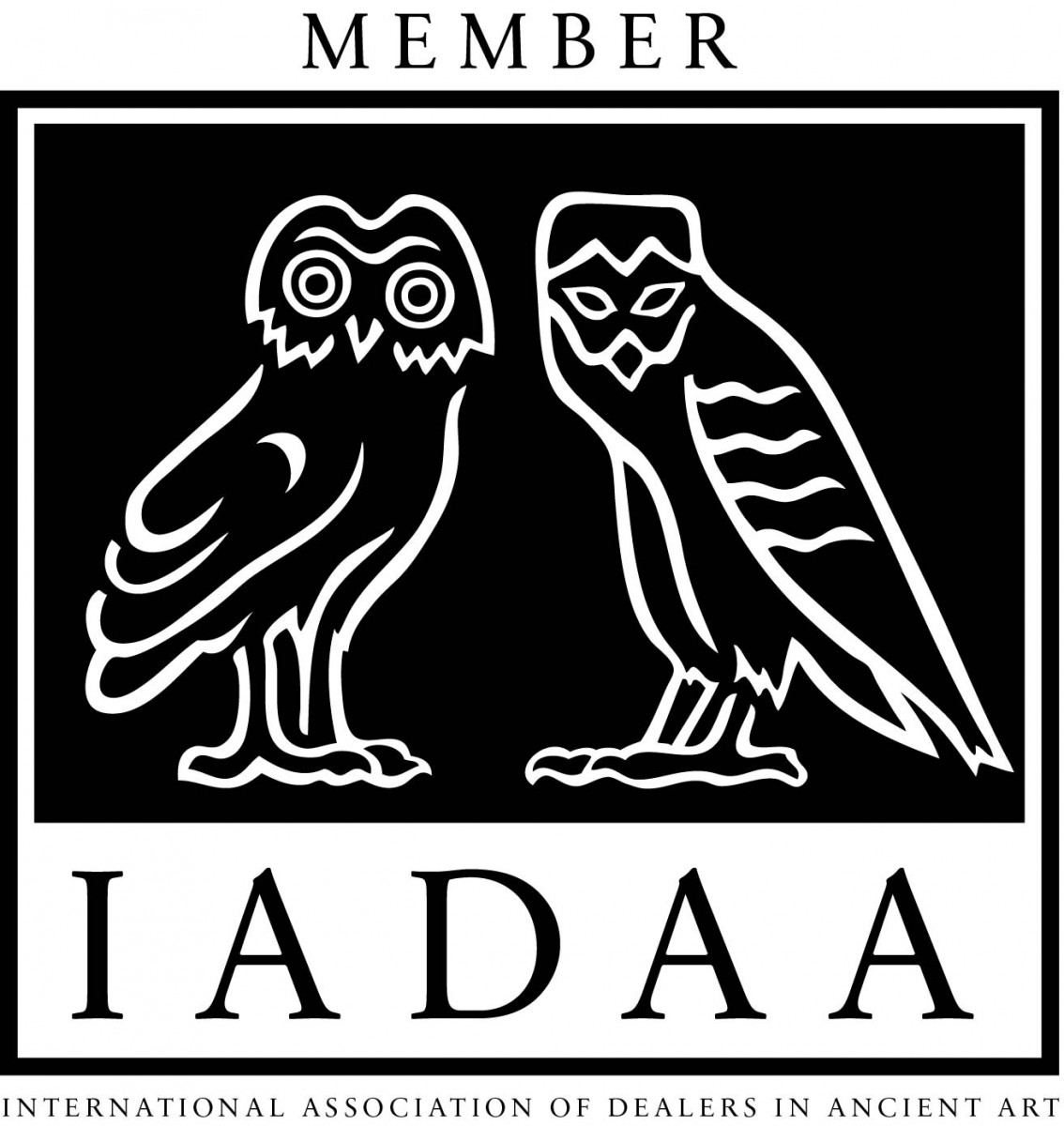
|
|
|
|